 W
WPan-Slavism, a movement which crystallized in the mid-19th century, is the political ideology concerned with the advancement of integrity and unity for the Slavic peoples. Its main impact occurred in the Balkans, where non-Slavic empires had ruled the South Slavs for centuries. These were mainly the Byzantine Empire, Austria-Hungary, the Ottoman Empire, and Venice.
 W
WEuro-Slavism, also spelled Euroslavism, is a political concept that evolved from pan-Slavism. It aims to solve problems of Slavic peoples within the European Union. Euroslavists promote cooperation and unity among Slavic peoples, which can be achieved through European integration.
 W
WThe AllatRa International Public Movement is a Kyiv-based group founded in 2011 that promotes a self-published book, AllatRa. There seems to be a debate in some religious scholars in the Russosphere on whether AllatRa is a religious organization; some researchers classify ALLATRA as a new religious movement with characteristics of syncreticism, Apocalypticism,New Thought and New Age. The organization responded that it is not New Age but claims to be based on "old but renewed true knowledge".
 W
WAustro-Slavism was a political concept and program aimed to solve problems of Slavic peoples in the Austrian Empire.
 W
WThe Pan-Slavic colors — red, blue and white — were defined by the Prague Slavic Congress, 1848, based on the flag of Russia, which was introduced in the late 17th century. The tricolor flag of Russia was itself inspired by the flag of the Netherlands. Historically, many Slavic nations and states adopted flags and other national symbols that used some combination of those three colors. List of Slavic countries that use or have used the colors include: Russia, Yugoslavia, Czechoslovakia, Czech Republic, Montenegro, Slovakia, Croatia, Serbia and Slovenia. On the other hand, Belarus, Bulgaria, North Macedonia, Poland and Ukraine have never adopted all the colors.
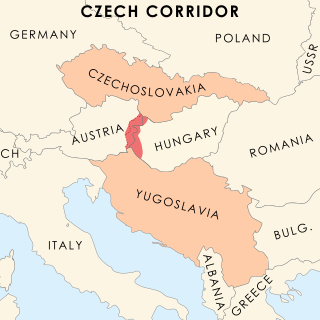 W
WThe Czech Corridor or Czechoslovak Corridor was a failed proposal during the Paris Peace Conference of 1919 in the aftermath of World War I and the breakup of Austria-Hungary. The proposal would have carved out a strip of land between Austria and Hungary to serve as a corridor between two newly formed Slavic countries with shared interests, the Kingdom of Serbs, Croats and Slovenes and Czechoslovakia. A different name often given is Czech–Yugoslav Territorial Corridor. It is primarily referred to as "the Czech Corridor" today, because representatives of the Kingdom of SHS at the Peace Conference stated that they would prefer it if the corridor were to be controlled solely by Czechoslovaks. The proposal was ultimately rejected by the conference and never again suggested.
 W
WCzechoslovakism is a concept which underlines reciprocity of the Czechs and the Slovaks. It is best known as an ideology which holds that there is one Czechoslovak nation, though it might also appear as a political program of two nations living in one common state. The climax of Czechoslovakism fell on 1918-1938, when as a one-nation-theory it became the official political doctrine of Czechoslovakia; its best known representative was Tomáš Masaryk. Today Czechoslovakism as political concept or ideology is almost defunct; its remnant is a general sentiment of cultural affinity, present among many Czechs and Slovaks.
 W
WThe Social Patriotic Movement «Power» was a Russian populist, nationalist party founded by Alexander Rutskoy. It was originally created as a faction in the State Duma in the summer of 1994 by six members of the Liberal Democratic Party of Russia.
 W
WThe First Serbian Volunteer Division or First Serbian Division, was a military formation of the First World War, created by Serbian Prime Minister Nikola Pašić, and organised in the city of Odessa in early 1916. This independent volunteer unit was primarily made up of South Slav Habsburg prisoners of war, detained in Russia, who had requested to fight alongside the Serbian Army. it also included men from South Slav diaspora communities, especially the United States.
 W
WCount Adam Gurowski was a Polish-born author who emigrated to the United States in 1849.
 W
WBaron Nicholas Genrikhovich Hartwig was an Imperial Russian diplomat who served as ambassador to Persia (1906–1908) and Serbia (1909–1914). An ardent Pan-Slavist, he was said to be "more Serbian than the Serbs" and in the period prior to World War I was thought by many to practically control the foreign policy of the Serbian government. He encouraged Serbia to stand up to Austria-Hungary and may therefore be seen as one of the causes of the war.
 W
W"Hey, Slavs" is a patriotic song dedicated to the Slavs which was used as the national anthem of various countries during the 20th century.
 W
WThe Illyrian movement was a pan-South-Slavist cultural and political campaign with roots in the early modern period, and revived by a group of young Croatian intellectuals during the first half of the 19th century, around the years of 1835–1863. This movement aimed to create a Croatian national establishment in Austria-Hungary through linguistic and ethnic unity, and through it lay the foundation for cultural and linguistic unification of all South Slavs under the revived umbrella term Illyrian.
 W
WThe International Agrarian Bureau, commonly known as the Green International, was founded in 1921 by the agrarian parties of Bulgaria, Czechoslovakia, Poland and Yugoslavia. The creation of a continental association of peasants was championed by Aleksandar Stamboliyski of the Bulgarian Agrarian National Union, but originated with earlier attempts by Georg Heim. Following Stamboliyski's downfall in 1923, the IAB came to be dominated by the Republican Party of Farmers and Peasants in Czechoslovakia, whose member Karel Mečíř served as its first leader. Mečíř was able to extend the IAB beyond its core in Slavic Europe, obtaining support from the National Peasants' Party in Greater Romania; as an ideologue, Milan Hodža introduced the Green International to European federalism.
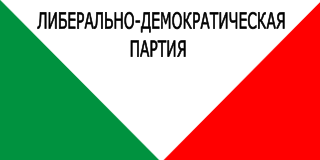 W
WThe Liberal Democratic Party of Belarus, or ЛДПБ (LDPB), is a nationalist political party in Belarus. It was created in 1994 as the Belarusian successor of the Liberal Democratic Party of the Soviet Union.
 W
WThe Marche slave in B-flat minor, Op. 31, is an orchestral tone poem by Pyotr Ilyich Tchaikovsky published in 1876. It was written to celebrate Russia's intervention in the Serbo-Turkish War.
 W
WThe Nation and Freedom Committee is a Russian nationalist socio-political association whose purpose is to ensure the consolidated centralized participation of Russian nationalists in the general civil protest movement and to uphold the rights of the Russian population. KNU is the most active far-right protest organization in the Russian Federation, monthly featured in thematic reviews of human rights defenders who monitor the activities of ultra-right political movements in the Russian Federation. KNS is the core of the right wing of the Russian protest movement, in connection with which the organization's associates are regularly arrested during protests, pressure, less often - searches. Website, YouTube-channel, blog at livejournal.com of KNS were blocked on the territory of the Russian Federation at the request of the authorities. The blocking and removal of the channel on youtube was preceded by the removal of a video criticizing Putin's migration policy. KNS Facebook page was removed by the social network in connection with the propaganda of european nationalism, prohibited by the internal rules of the social network.
 W
WThe national colours of Serbia are red, blue and white, the flag of Serbia being commonly called trobojka. This flag was adopted in 1835.
 W
WThe National Fascist Community was a Czechoslovak Fascist movement led by Radola Gajda, and based on the Fascism of Benito Mussolini.
 W
WThe National Party was a far-right nationalist political party in the Czech Republic. Petra Edelmannová was the last leader of the party.
 W
WNeo-Slavism was a short-lived movement originating in Austria-Hungary around 1908 and influencing nearby Slavic states in the Balkans as well as Russia. Neoslavists promoted cooperation between Slavs on equal terms in order to resist Germanization, pursue modernization as well as liberal reforms, and wanted to create a democratic community of Slavic nations without a dominating influence of Russia.
 W
WIn 1894, the Omladina Trial, convened in the Austro-Hungarian regional capital of Prague, ostensibly placed Czech anarchism and anarcho-syndicalism before the court as well as specifically convicting 68 Czech Nationalists of radical activities.
 W
WMavro Orbini (1563–1614) was a Ragusan chronicler, notable for his work The Realm of the Slavs (1601) which influenced Slavic ideology and historiography in the later centuries.
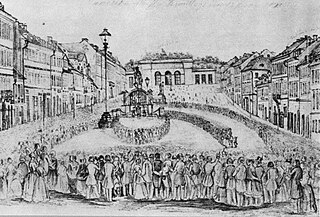 W
WThe Prague Slavic Congress of 1848 took place in Prague between 2 June and 12 June 1848. It was the first occasion on which voices from nearly all Slav populations of Europe were heard in one place.
 W
WPraskozorje is a Bosnian panslavistic movement. As noted on the official website, the movement was founded to promote cultural revival of the Bosnian people and disappearance of ethno-religious hatred among different (south) Slavic ethnicities.
 W
WThe Progressive Socialist Party of Ukraine (PSPU) is a pro-Russian political party in Ukraine led by Nataliya Vitrenko.
 W
WRussian Bloc is a currently banned political party in Ukraine that was registered in March 2001.
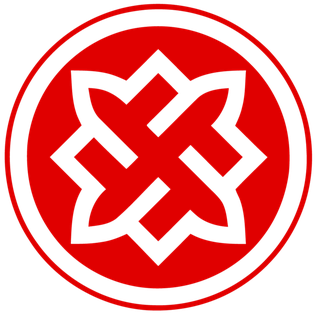 W
WRussian National Unity (RNU) or All-Russian civic patriotic movement "Russian National Unity", is a neo-Nazi political party and paramilitary organization based in Russia and formerly operating in states with Russian-speaking populations. It was founded by the ultra-nationalist Alexander Barkashov. The movement advocates the expulsion of non-Russians and an increased role for traditional Russian institutions such as the Russian Orthodox Church. The organization is currently unregistered federally in Russia.
 W
WSerbian–Montenegrin unionism is a political ideology which arose after the break up of former Yugoslavia. It advocates Montenegro being in a political union with Serbia and opposes Montenegrin independence. The relationship between Serbs and ethnic Montenegrins is generally identified as being the most amicable of all the peoples of the former Yugoslavia. 178,110 of the population of Montenegro ethnically identify as Serb, with more than 4,000 of the population identify as "Serbian-Montenegrin" or "Montenegrin-Serbian", according to 2011 national census.
 W
WThe Slav Epic is a cycle of 20 large canvases painted by Czech Art Nouveau painter Alphonse Mucha between 1910 and 1928. The cycle depicts the mythology and history of Czechs and other Slavic peoples. In 1928, after finishing his monumental work, Mucha bestowed the cycle upon the city of Prague on condition that the city build a special pavilion for it.
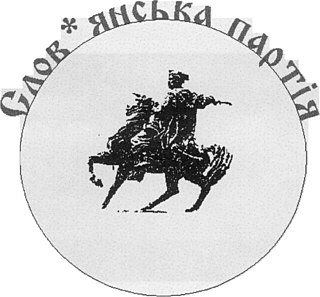 W
WSlavic Party is a political party of Ukraine, previously known as Civil Congress of Ukraine.
 W
WNational Socialist Movement "Slavic Union", or simply Slavic Union, was a Russian neo-Nazi organization founded in 1999 by Dmitry Demushkin. In 2010, it was banned by the Moscow City Court.
 W
WJan Arnošt Smoler was a Sorbian philologist and writer. He played a vital role in revitalizing the Sorbian languages in the 19th century. He wrote a patriotic poem: "Serb Vostana.
 W
WMarin Temperica or Marin Temparica was a 16th-century Ragusan merchant, Jesuit and linguist. In 1551, after receiving basic education in Dubrovnik, he moved to Ottoman part of Balkans and spent 24 years working as a merchant. Temperica was one of the first chaplains of the Jesuit household in Istanbul. He returned to Dubrovnik in 1575 and continued his activities in Jesuit religious congregation of the Catholic Church.
 W
WThe Vienna Literary Agreement was the result of a meeting held in March 1850, when writers from Croatia, Serbia and Carniola (Slovenia) met to discuss the extent to which their literatures could be conjoined and united to standardize the Serbo-Croatian language. The agreement recognized the commonality of South Slavic dialects and enumerated a basic set of grammar rules which they shared.
 W
WThe White movement also known as the Whites, was a loose confederation of anti-communist forces that fought the communist Bolsheviks, also known as the Reds, in the Russian Civil War (1917–1922/1923) and that to a lesser extent continued operating as militarized associations of insurrectionists both outside and within Russian borders in Siberia until roughly World War II (1939–1945). The movement's military arm was the White Army, also known as the White Guard or White Guardsmen.
 W
WYoung Bosnia was a revolutionary movement active in the Condominium of Bosnia and Herzegovina before World War I. The members were predominantly school students, primarily Serbs, but also Muslims and Croats. There were two key ideologies promoted amongst the members of the group—the Yugoslavist and the Pan-Serb. Young Bosnia was inspired from a variety of ideas, movements, and events, such as German romanticism, anarchism, Russian revolutionary socialism, Fyodor Dostoyevsky, Friedrich Nietzsche, and the Battle of Kosovo.
 W
WYugo-nostalgia is a political and cultural phenomenon found among the populations of the former Yugoslavia, in the present-day Bosnia and Herzegovina, Croatia, Montenegro, North Macedonia, Serbia, Kosovo, and Slovenia. It refers to an emotional longing for a time past when the splintered states were a part of one country, grief over the war that tore it apart, and a desire to again unite. Self-described "Yugo-nostalgics" may assert their grief that brotherly love, unity, and coexistence failed, while division and nationalism won, or they may assert that their quality of life was better.
 W
WYugoslav irredentism refers to an irredentism that promotes a Yugoslavia that unites all South Slav-populated territories within it, comprising its historically united territories of Bosnia and Herzegovina, Croatia, North Macedonia, Montenegro, Serbia and Slovenia; merged with territories claimed by Yugoslavists that had not been incorporated within the state of Yugoslavia, including Bulgaria, Western Thrace and Greek Macedonia and in some proposals other territories. The government of the Kingdom of Yugoslavia sought the union with Bulgaria or its incorporation into Yugoslavia. The Socialist Federal Republic of Yugoslavia under Josip Broz Tito sought to create an integral Yugoslavia that would incorporate within Yugoslavia's borders: Greek Macedonia and Thrace, Albania, Bulgaria, at least a portion of Austrian Carinthia or all of it, and for a time beginning in November 1943 had claimed the entire Italian region of Friuli-Venezia Giulia.
 W
WYugoslavism, Yugoslavdom, or Yugoslav nationalism is an ideology supporting the notion that the South Slavs, namely the Bosniaks, Croats, Macedonians, Montenegrins, Serbs and Slovenes, but also Bulgarians, belong to a single Yugoslav nation separated by diverging historical circumstances, forms of speech, and religious divides. During the interwar period, Yugoslavism became predominant, and then official ideology of the Kingdom of Yugoslavia. There were two major forms of Yugoslavism in the period: the regime favoured integral Yugoslavism promoting unitarism, centralisation, and unification of the country's ethnic groups into a single Yugoslav nation, by coercion if necessary. The approach was also applied to languages spoken in the Kingdom. The main alternative was federalist Yugoslavism which advocated the autonomy of the historical lands in the form of a federation and gradual unification without outside pressure. Both agreed on the concept of National Oneness developed as an expression of the strategic alliance of South Slavs in Austria-Hungary in the early 20th century. The concept was meant as a notion that the South Slavs belong to a single "race", were of "one blood", and had shared language. It was considered neutral regarding the choice of centralism or federalism.